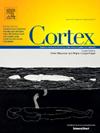移动身体中线:虚拟现实中视觉运动调节对周边自主神经活动的影响
IF 3.3
2区 心理学
Q1 BEHAVIORAL SCIENCES
引用次数: 0
摘要
连贯的身体所有权和位置感依赖于自上而下和自下而上的感官信号的整合。通过实验性幻觉破坏这种一致性可以改变身体表征和外围生理状态,如体温。为了进一步研究这种联系,我们开发了一种新的虚拟现实(VR)范式,该范式通过在视觉运动任务中将左手虚拟地重新定位到身体的右侧来操纵空间身体表征。参与者(n = 26)参与了一个15分钟的沉浸式VR任务,用他们的右手用棍子操纵一个虚拟立方体。在相同的条件下,虚拟的手与他们实际的右手相匹配。在不一致条件下,右手在视觉上被左手取代,移动了感知到的身体中线。我们记录了任务前和过程中的左手温度、皮肤电刺激的皮肤电导反应(SCRs)、本体感觉漂移(PD)和主观测量(体现、代理、身体感知改变和不愉快)。结果显示,在不一致的条件下,左手温度显著降低,而在一致的条件下,左手温度显著增加。SCR振幅与温度相关:冷却与SCR降低有关,而变暖预测更强的反应。PD显示,在各种情况下,感知到的手指位置向右移动,可能是由于任务的单侧性质。不同条件下的主观评分相似。总的来说,我们的研究结果表明,视觉运动操纵破坏连贯的身体参照系可以诱导可测量的生理变化,即使在没有改变主观经验的情况下,突出了身体表征和周围身体信号之间的联系。本文章由计算机程序翻译,如有差异,请以英文原文为准。
Shifting the body midline: The impact of visuomotor modulations in virtual reality on peripheral autonomic activity
A coherent sense of body ownership and position depends on the integration of top-down and bottom-up sensory signals. Disrupting this coherence through experimental illusions can alter body representation and peripheral physiological states, such as body temperature. To further investigate this link, we developed a novel virtual reality (VR) paradigm that manipulates spatial body representation by virtually repositioning the left hand into the right side of the body during a visuomotor task. Participants (n = 26) engaged in a 15-min immersive VR task using their right hand to manipulate a virtual cube with a stick. In the congruent condition, the virtual hand matched their actual right hand. In the incongruent condition, the right hand was visually replaced by a left hand, shifting the perceived body midline. We recorded left-hand temperature before and during the task, skin conductance responses (SCRs) to electrocutaneous stimulation, proprioceptive drift (PD), and subjective measures (embodiment, agency, altered body perception, and unpleasantness). Results showed a significant decrease in left-hand temperature in the incongruent condition, compared to an increase in the congruent condition. SCR amplitude correlated with temperature: cooling was associated with reduced SCRs, while warming predicted stronger responses. PD revealed a rightward shift in perceived finger position across conditions, likely due to the task's unilateral nature. Subjective ratings were similar across conditions. Overall, our findings demonstrate that visuomotor manipulations disrupting coherent body reference frames can induce measurable physiological changes, even in the absence of altered subjective experience, highlighting a link between body representation and peripheral bodily signals.
求助全文
通过发布文献求助,成功后即可免费获取论文全文。
去求助
来源期刊

Cortex
医学-行为科学
CiteScore
7.00
自引率
5.60%
发文量
250
审稿时长
74 days
期刊介绍:
CORTEX is an international journal devoted to the study of cognition and of the relationship between the nervous system and mental processes, particularly as these are reflected in the behaviour of patients with acquired brain lesions, normal volunteers, children with typical and atypical development, and in the activation of brain regions and systems as recorded by functional neuroimaging techniques. It was founded in 1964 by Ennio De Renzi.
 求助内容:
求助内容: 应助结果提醒方式:
应助结果提醒方式:


